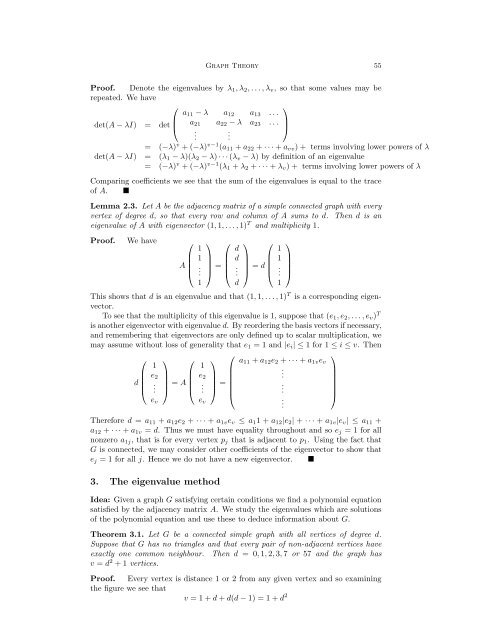You also want an ePaper? Increase the reach of your titles
YUMPU automatically turns print PDFs into web optimized ePapers that Google loves.
<strong>Graph</strong> <strong>Theory</strong> 55Proof. Denote the eigenvalues by λ 1 , λ 2 , . . . , λ v , so that some values may berepeated. We have⎛⎞a 11 − λ a 12 a 13 . . .⎜det(A − λI) = det ⎝a 21 a 22 − λ a 23 . . . ⎟⎠. .= (−λ) v + (−λ) v−1 (a 11 + a 22 + · · · + a vv ) + terms involving lower powers of λdet(A − λI) = (λ 1 − λ)(λ 2 − λ) · · · (λ v − λ) by definition of an eigenvalue= (−λ) v + (−λ) v−1 (λ 1 + λ 2 + · · · + λ v ) + terms involving lower powers of λComparing coefficients we see that the sum of the eigenvalues is equal to the traceof A. Lemma 2.3. Let A be the adjacency matrix of a simple connected graph with everyvertex of degree d, so that every row and column of A sums to d. Then d is aneigenvalue of A with eigenvector (1, 1, . . . , 1) T and multiplicity 1.Proof.We have⎛A ⎜⎝11.1⎞ ⎛⎟⎠ = ⎜⎝dd.d⎞ ⎛⎟⎠ = d ⎜⎝This shows that d is an eigenvalue and that (1, 1, . . . , 1) T is a corresponding eigenvector.To see that the multiplicity of this eigenvalue is 1, suppose that (e 1 , e 2 , . . . , e v ) Tis another eigenvector with eigenvalue d. By reordering the basis vectors if necessary,and remembering that eigenvectors are only defined up to scalar multiplication, wemay assume without loss of generality that e 1 = 1 and |e i | ≤ 1 for 1 ≤ i ≤ v. Then⎞⎛d ⎜⎝1e 2.e v⎞ ⎛⎟⎠ = A ⎜⎝1e 2.e v11.1.⎞⎟⎠⎛⎞ a 11 + a 12 e 2 + · · · + a 1v e v⎟⎠ = .⎜⎝.⎟⎠Therefore d = a 11 + a 12 e 2 + · · · + a 1v e v ≤ a 1 1 + a 12 |e 2 | + · · · + a 1v |e v | ≤ a 11 +a 12 + · · · + a 1v = d. Thus we must have equality throughout and so e j = 1 for allnonzero a 1j , that is for every vertex p j that is adjacent to p 1 . Using the fact thatG is connected, we may consider other coefficients of the eigenvector to show thate j = 1 for all j. Hence we do not have a new eigenvector. 3. The eigenvalue methodIdea: Given a graph G satisfying certain conditions we find a polynomial equationsatisfied by the adjacency matrix A. We study the eigenvalues which are solutionsof the polynomial equation and use these to deduce information about G.Theorem 3.1. Let G be a connected simple graph with all vertices of degree d.Suppose that G has no triangles and that every pair of non-adjacent vertices haveexactly one common neighbour. Then d = 0, 1, 2, 3, 7 or 57 and the graph hasv = d 2 + 1 vertices.Proof. Every vertex is distance 1 or 2 from any given vertex and so examiningthe figure we see thatv = 1 + d + d(d − 1) = 1 + d 2













